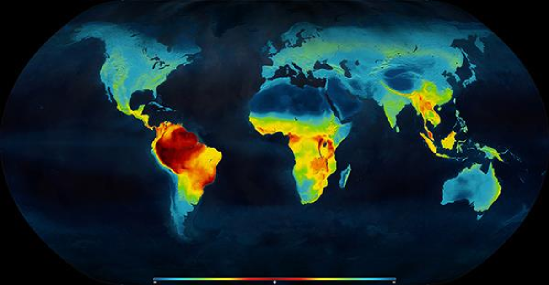Map_latitudinal_gradient_of_biodiversity_mannion_2014.png
Summary
| Description Map latitudinal gradient of biodiversity mannion 2014.png |
English:
example of
latitudinal gradient of species diversity
: distribution of living terrestrial vertebrate species, highest concentration of diversity shown in red in equatorial
regions, declining polewards (towards the blue end of the spectrum)
Deutsch:
Beispiel für den latitudinalen Biodiversitätsgradienten: Verteilung lebender terrestrischer Wirbeltierarten. Die höchste Artenzahl pro Flächeneinheit finden sich nahe dem Äquator (rote Farben), sie nimmt Richtung beider Pole ab (zunehmend blauer Farbton).
|
| Date | |
| Source | Palaeontology [online] (www.palaeontologyonline.com): Mannion, P. D. 2014. Patterns in Palaeontology: The latitudinal biodiversity gradient. Palaeontology Online, Volume 4, Article 3, 1-8. Map created by GLOBAÏA . |
| Author | Mannion, P. D., Upchurch, P., Benson, R. B. J. & Goswami, A., based on work by Clinton Jenkins |
Paleontology Online publishes work under Creative Commons license. For copyright details see: http://www.palaeontologyonline.com/site-information/copyright/ .
Licensing
This file is licensed under the
Creative Commons
Attribution 3.0 Unported
license.
Attribution:
Mannion, P. D. 2014. Patterns in Palaeontology: The latitudinal biodiversity gradient. Palaeontology Online, Volume 4, Article 3, 1-8.
-
You are free:
- to share – to copy, distribute and transmit the work
- to remix – to adapt the work
-
Under the following conditions:
- attribution – You must give appropriate credit, provide a link to the license, and indicate if changes were made. You may do so in any reasonable manner, but not in any way that suggests the licensor endorses you or your use.
Captions
Add a one-line explanation of what this file represents
Verspreiding van de gewervelde landsoorten. De hoogste concentratie aan diversiteit wordt in het rood weergegeven (vooral in gebieden dicht bij de evenaar), lage concentraties in het blauw (vooral naar de polen toe en bij woestijnen).

